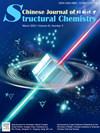从[Ba3S][GeS4]到[Ba3CO3][MS4] (M = Ge, Sn):通过官能团注入增强红外双折射晶体的光学各向异性
IF 10.3
4区 化学
Q1 CHEMISTRY, INORGANIC & NUCLEAR
引用次数: 0
摘要
双折射晶体对于控制光的相位和偏振至关重要,使它们成为各种光学设备的重要部件。传统上,设计高性能双折射晶体的策略主要集中在改变母体结构上。然而,证明改变官能团如何有效增强双折射的例子有限(Δn),因为这种变化通常会显著改变晶体结构。在本研究中,我们提出了一种“官能团植入”策略,旨在显著提高硫系体系的双折射性能。这包括用各向异性的π共轭[CO3]2 -基团取代各向同性的[S]2 -离子。我们通过综合比较硫族化合物[Ba3S][GeS4]和氧硫族化合物[Ba3CO3][MS4] (M = Ge和Sn),验证了这一方法,两者采用相同的空间基团,官能团排列方式相同。实验表征和理论计算证实了[CO3]2 -基团比[S]2 -基团具有更大的极化各向异性。与[Ba3S][GeS4](在546 nm时为0.021)相比,这种差异导致[Ba3CO3][MS4](在546 nm时为0.088至0.112)的Δn值显著增加。这一发现不仅拓宽了π共轭硫族化合物的结构化学,而且说明了官能团注入在设计具有增强光学各向异性的红外双折射晶体方面的潜力。本文章由计算机程序翻译,如有差异,请以英文原文为准。
![From [Ba3S][GeS4] to [Ba3CO3][MS4] (M = Ge, Sn): Enhancing optical anisotropy in IR birefringent crystals via functional group implantation](https://img.booksci.cn/booksciimg/2025-1/99296620001769078192.jpg)
From [Ba3S][GeS4] to [Ba3CO3][MS4] (M = Ge, Sn): Enhancing optical anisotropy in IR birefringent crystals via functional group implantation
Birefringent crystals are crucial for manipulating light's phase and polarization, making them vital components in various optical devices. Traditionally, strategies for designing high-performance birefringent crystals have focused on modifying the parent structure. However, there are limited examples demonstrating how changing functional groups can effectively enhance birefringence (Δn), as such changes often significantly alter the crystal structure. In this study, we propose a “functional group implantation” strategy aiming at significantly improving birefringent performance within the chalcogenide system. This involves replacing the isotropic [S]2– ions with anisotropic π-conjugated [CO3]2– groups. We validated this approach through comprehensive comparisons between the chalcogenide [Ba3S][GeS4] and oxychalcogenide [Ba3CO3][MS4] (M = Ge and Sn), both of which adopt the same space group and feature the same arrangements of functional groups. Experimental characterization and theoretical calculations confirm that the [CO3]2– groups exhibit significantly greater polarization anisotropy than the [S]2– groups. This difference leads to a marked increase in Δn in [Ba3CO3][MS4] (ranging from 0.088 to 0.112 at 546 nm) compared to [Ba3S][GeS4] (0.021 at 546 nm). This finding not only broadens the structural chemistry of π-conjugated chalcogenides but also illustrates the potential of functional group implantation for designing infrared birefringent crystals with enhanced optical anisotropy.
求助全文
通过发布文献求助,成功后即可免费获取论文全文。
去求助
来源期刊

结构化学
化学-晶体学
CiteScore
4.70
自引率
22.70%
发文量
5334
审稿时长
13 days
期刊介绍:
Chinese Journal of Structural Chemistry “JIEGOU HUAXUE ”, an academic journal consisting of reviews, articles, communications and notes, provides a forum for the reporting and discussion of current novel research achievements in the fields of structural chemistry, crystallography, spectroscopy, quantum chemistry, pharmaceutical chemistry, biochemistry, material science, etc. Structural Chemistry has been indexed by SCI, CA, and some other prestigious publications.
 求助内容:
求助内容: 应助结果提醒方式:
应助结果提醒方式:


